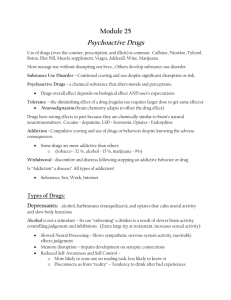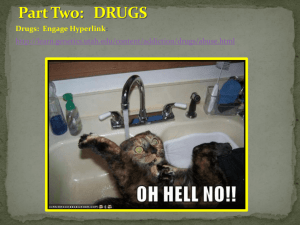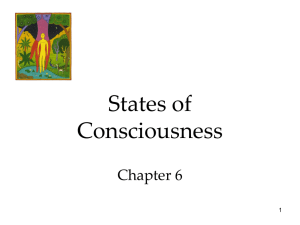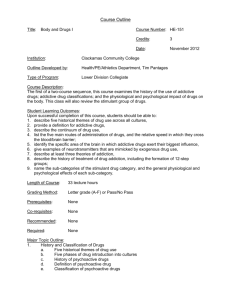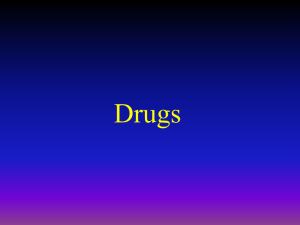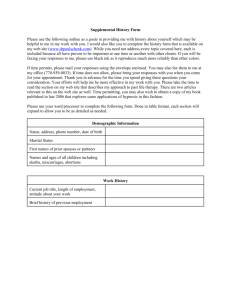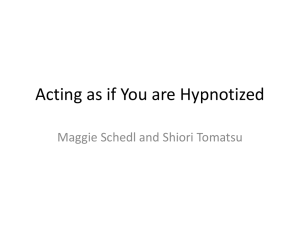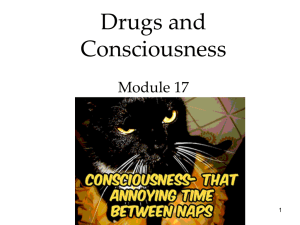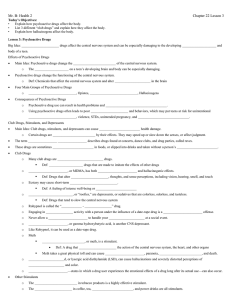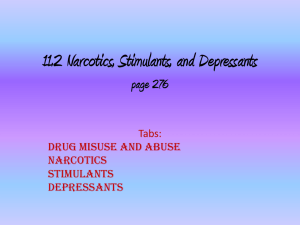Powerpoint
advertisement
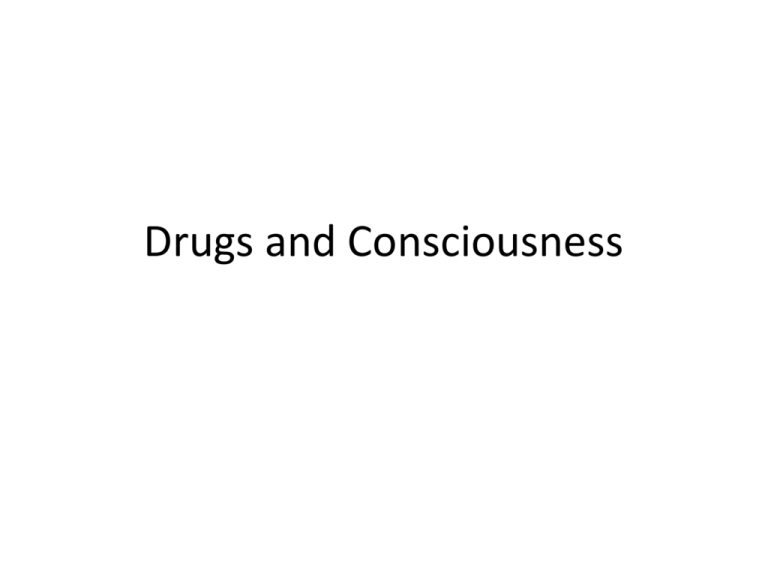
Drugs and Consciousness DO NOW 1. Which of the following is NOT a theory of dreaming? a) b) c) d) Dreams facilitate information processing. Dreaming stimulates the developing brain. Dreams result from random neural activity. Dreaming is an attempt to escape from social stimulation. e) Dreaming demonstrates our advanced cognitive processing. DO NOW 2. Those who consider hypnosis a result of social influence would claim: a) Hypnosis is an altered state of consciousness. b) Hypnotized people are simply acting out a role as instructed by an authoritarian figure. c) Acts done while under hypnosis are unique to hypnosis. d) Brain waves actually change hypnotized patients. e) All of the above. DO NOW 3. Melinda dreams that her boyfriend pushes her in front of an oncoming car. Her psychoanalyst suggests that the dream might symbolize her fear that her boyfriend is rushing her into sexual activity prematurely. The analyst is using the storyline of Melinda’s dream, or __________ content, to determine the underlying meaning, or __________content. a) b) c) d) e) manifest; latent dissociated; overt latent; manifest overt; manifest latent; dissociated Quick video on SLEEP • https://www.youtube.com/watch?v=D1et5Ng T6bQ Drugs and Consciousness • Our brain is protected by a layer of capillaries called the blood-brain barrier. • The drugs that are small enough to pass through are called psychoactive drugs. Drugs and Consciousness Psychoactive Drug a chemical substance that alters perceptions and mood Physical Dependence physiological need for a drug marked by unpleasant withdrawal symptoms Psychological Dependence a psychological need to use a drug for example, to relieve negative emotions Dependence and Addiction Big effect Drug effect Tolerance diminishing effect with regular use Response to first exposure Withdrawal After repeated exposure, more drug is needed to produce same effect Little effect Small Large Drug dose discomfort and distress that follow discontinued use Drugs are either…. • Agonists – mimic the effects of neurotransmitters • Antagonists – block the brain’s neurotransmitters Agonists and Antagonists Psychoactive Drugs – 4 categories Depressants drugs that reduce neural activity slow body functions alcohol, barbiturates, opiates Stimulants drugs that excite neural activity speed up body functions caffeine, nicotine, amphetamines, cocaine 1. Depressants • Slows down body processes. • Alcohol – most harmful drug in the US – involved in 60% of ALL crimes – involved in over 70% of sexually related crimes 2. Stimulants • Speed up body processes. • More powerful ones (like cocaine) give people feelings of invincibility. Cocaine Euphoria and Crash Stimulants • Methamphetamines – Before Meth – 1998 – “Faces of Meth” After - 2002 3. Hallucinogens • Also called psychedelics. – Create a loss of contact with reality. – produce sensory or perceptual distortions called hallucinations Examples – LSD – PCP – MDMA (Ecstasy) – Ketamine – Marijuana (THC) 4. Opiates – decreases neural activity and highly addictive – acts as an analgesic or pain reliever – Examples • • • • Morphine Heroine Methadone Codeine ©John Wiley & Sons, Inc. 2007 Huffman: Psychology in Action (8e) DO NOW 2. Dan has recently begun using an addictive, euphoria-producing drug. Which of the following will probably occur if he repeatedly uses this drug? a. As tolerance to the drug develops, Dan will experience increasingly pleasurable “highs.” b.The dosage needed to produce the desired effect will increase. c. After each use, he will become more and more elated. d.Dependence will become less of a problem. e. None of the above. DO NOW 1. Which of the following is NOT a stimulant? a. Caffeine b. Amphetamines c. Methamphetamines d. Nicotine e. Opiates 1. The most common daydreaming themes are typically related to sex, the conquering hero, or the __________________. a. Superstitious superhero b. Suffering martyr c. Antagonistic villain d. Weeping victim e. None of the above. 1. Dan has recently begun using an addictive, euphoria-producing drug. Which of the following will probably occur if he repeatedly uses this drug? a. As tolerance to the drug develops, Dan will experience increasingly pleasurable “highs.” b. The dosage needed to produce the desired effect will increase. c. After each use, he will become more and more elated. d. Dependence will become less of a problem. None of the above. Today’s Agenda • Module 15: Hypnosis and Meditation – Practice Test – Multiple Choice – Matching • Review answers • Module 16: Drug Use – Highs & Lows – Same as Module 15 • Review answers Module 15: Practice Test WORD BANK • Treating psychological • disorders • Meditation • • Controlling pain • • Mantra • Hypnosis • Reducing smoking Assisting in law enforcement Ineffability Improving athletic performance Module 16: Practice Test WORD BANK • Psychologically based • Cocaine • Rohypnol • Hallucinogens • Addictive drugs • Narcotics • Intoxication • Caffeine • LSD, acid • • • • • • • • • • Amphetamines Binge drinking MDMA (ecstasy) Biologically based Depressants Stimulants Methadone Barbiturates Psychoactive drugs Alcohol • • • • • • • Alcoholics Opiates (narcotics) Nicotine Methamphetamines Morphine Marijuana Heroine
